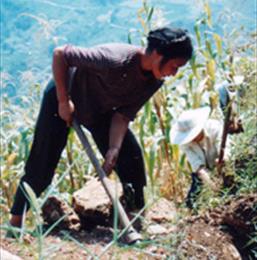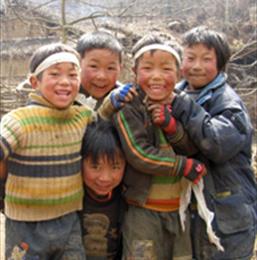Jun/July 2003
31st July 2003
Drinking and Irrigation Water supply System
Through partnerships between donor organisations, DORS, and local communities over the last six years 10,563 villagers in seventeen villages from Hanyuan and Ganluo Counties, now have access to clean water and five villages have a new irrigation system, these projects in total have cost RMB 1,050,886 (GBP 87,574). In this issue, DORS will introduce its water supply projects, by giving an overview of how a water project is carried out.
The problem
In many villages where DORS has implemented water system projects, there was no piped system previously. Natural shallow wells, springs, or water storage ponds were used, however, the water was insufficient in the winter and people had to walk several hundred meters to fetch water in buckets. The water in the shallow wells or at the stream was often not enough, and as a result, they had to wait a long time to fill up their buckets. The villagers spent several hours each day collecting water thus spending less time working in their fields. The water was unclean especially after heavy rain in summer time or in the winter, when the water levels were low and villagers had to scoop water from the wells or the streams, thus stirring up mud and picking up parasites. This was a health hazard and the shortage of water, in general, brought hygienic and sanitation problems. The water problem also affected the development of animal husbandry projects and irrigation of fields.
The action
As for any of DORS projects, the decision to carry out a drinking or irrigation water system project is made by the villagers themselves. A meeting is carried out in the village, where representatives of the different households discuss the project feasibility and division of labour. After discussion with the villagers, the Water Conservancy Bureau or other water engineer designs the water system. The design is discussed in detail in the village, and modified if necessary, until all are in agreement of the piping sizes, positions and tank details. All systems are gravity flow systems bringing stream or spring water by pipe into a water storage tank, and then piped to a tapstand in each family's courtyard. The portion of the funds that DORS provides is given to the village leaders or the members of the Village Management Committee (responsible for DORS projects in the village), who manage the finances. They then purchase the piping and materials and arrange for transport (to the closest road to the village) and storage of materials in the village. In some cases, the Township leaders or DORS have arranged for purchase and transport of materials. The villagers provide all the labour and also put in a small financial contribution to the project, for e.g. funds for buying their taps. The engineer who designs the plan oversees the project implementation by visiting the village at each stage of the project and trains a few villagers for the different steps, like cutting the pipes, digging the trenches (dimensions and measurements etc) and laying and connecting the pipes, building the water tanks and household sinks. The trained villagers then instruct the rest of the villagers how to carry out the construction work. The villagers also have to carry materials from the road to the village and to different part of the water system. Each hamlet is assigned a section of the pipe path to prepare and each household builds their own sink. The work is organised by the villagers themselves. The labour is arranged on a per labourer basis. If there are two labourers in a household, then both are assigned a period of days to work. This labour requirement is time consuming but the villagers are eager to put in labour to build or fix their water supply system.
When the project is near completion, the villagers hold meetings to facilitate the management and long-term sustainability of the project. This is to ensure clarity on who is responsible for the maintenance of the water project, the responsibilities of the villagers towards the water system, and the user rules and regulations. DORS closely monitors the project at all stages, and ensures the villagers are getting the technical assistance they need.
The benefit
A piped water supply improves health and sanitation, saves time lost in fetching water, and enables villagers to raise more livestock and grow vegetables both through improved water availability and through having more time to engage in agricultural production or other activities. Increased agricultural production could either be used directly for consumption or for sale on the market. Women, who provide much of the agricultural labour force, benefit a lot, as together with children, are the primary water carriers and users.
Where an irrigation system has been set up, water will be used not only for irrigation but in some areas, dry land can be converted into paddy, which will enable the villagers to grow rice which is preferred over planting for example, corn and potatoes. Growing two seasons of crops rather than one makes a significant impact on the villagers' income.
Project Progress
Animal Sties and Fuel-efficient Stoves in Teke Village
These two projects started in April 2003 and are components of the Kadoorie Integrated Community Development Programme. DORS staff visited the village to assess the needs of the villagers in improving stoves and sties and meetings were conducted in the two hamlets of Teke Village, where the villagers were able to raise questions and concerns about the details of the project. Teke Village is situated on a very steep hillside of approx. 30 degrees at an elevation of about 1500m. During the baseline study, it was revealed that due to the ban on cutting trees from the neighbouring forest, villagers do not have enough wood to repair their sties; roofs are often made of straw and leak. With improved sties, the livestock environment would be cleaner and healthier. Shortage of fuel wood was also a concern. Some households use maize stalks as fuel. The amount of time the villagers spend in collecting wood can be decreased as these fuel-efficient stoves save on the amount of fuel wood needed by 50% compared to the ones used currently in the village. Since the project started, 95 households out of the 187 households in the village have finished their stoves. Those who have finished building their stoves are now preparing the cement blocks that are needed to build the walls for the sties. So far, 105 tonnes of cement has been transported to the village. The project is expected to be completed in October 2003.
Animal Sties and Fuel-efficient Stoves in Teke Village
These two projects started in April 2003 and are components of the Kadoorie Integrated Community Development Programme. DORS staff visited the village to assess the needs of the villagers in improving stoves and sties and meetings were conducted in the two hamlets of Teke Village, where the villagers were able to raise questions and concerns about the details of the project. Teke Village is situated on a very steep hillside of approx. 30 degrees at an elevation of about 1500m. During the baseline study, it was revealed that due to the ban on cutting trees from the neighbouring forest, villagers do not have enough wood to repair their sties; roofs are often made of straw and leak. With improved sties, the livestock environment would be cleaner and healthier. Shortage of fuel wood was also a concern. Some households use maize stalks as fuel. The amount of time the villagers spend in collecting wood can be decreased as these fuel-efficient stoves save on the amount of fuel wood needed by 50% compared to the ones used currently in the village. Since the project started, 95 households out of the 187 households in the village have finished their stoves. Those who have finished building their stoves are now preparing the cement blocks that are needed to build the walls for the sties. So far, 105 tonnes of cement has been transported to the village. The project is expected to be completed in October 2003.


